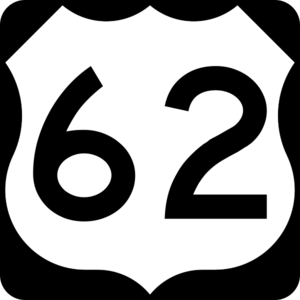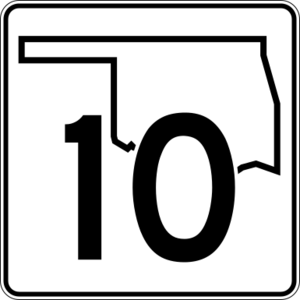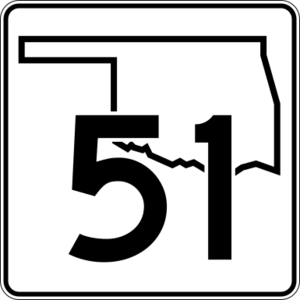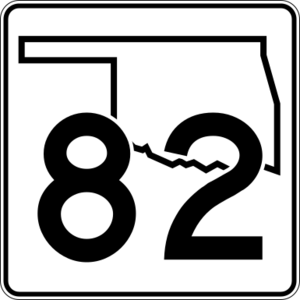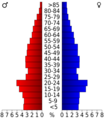Cherokee County, Oklahoma facts for kids
Quick facts for kids
Cherokee County
|
|
|---|---|

|
|
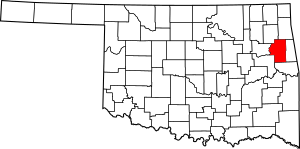
Location within the U.S. state of Oklahoma
|
|
 Oklahoma's location within the U.S. |
|
| Country | |
| State | |
| Founded | 1907 |
| Named for | Cherokee Nation |
| Seat | Tahlequah |
| Largest city | Tahlequah |
| Area | |
| • Total | 776 sq mi (2,010 km2) |
| • Land | 749 sq mi (1,940 km2) |
| • Water | 27 sq mi (70 km2) 3.5%% |
| Population
(2020)
|
|
| • Total | 47,078 |
| • Density | 60.67/sq mi (23.424/km2) |
| Time zone | UTC−6 (Central) |
| • Summer (DST) | UTC−5 (CDT) |
| Congressional district | 2nd |
Cherokee County is a county in the state of Oklahoma. In 2020, about 47,078 people lived here. The main town and county seat is Tahlequah. Tahlequah is also the capital city of the Cherokee Nation.
Cherokee County is part of the Tahlequah area. This area is also connected to larger cities like Tulsa and Muskogee.
Contents
History of Cherokee County
Cherokee County was created in 1907. Some records say it was formed from the Tahlequah District of the Cherokee Nation in 1906.
The Cherokee people moved to this area because they were forced to leave their homes. This happened due to the Indian Removal Act of 1830. This sad journey is known as the Trail Of Tears. The first important settlements were at Park Hill and Tahlequah. Tahlequah became the center of the Cherokee government.
However, the American Civil War divided the Cherokee tribe. Many early buildings were destroyed during this time. Later, in the mid-1870s, more non-Cherokee people started moving into the area. By the 1890s, they became the majority.
In 1851, schools for Cherokee boys and girls opened. The Cherokee Male Seminary was in Tahlequah. The Cherokee Female Seminary was in Park Hill. The girls' school burned down in 1887 but was rebuilt in Tahlequah. The boys' school was destroyed by fire in 1910. After Oklahoma became a state in 1907, the Female Seminary became Northeastern State Normal School. Today, it is part of Northeastern State University.
From 1901 to 1903, the first railway tracks were built in the county. This railway helped farmers send their products to other places. But during the Great Depression, the railway business slowed down a lot. All train service stopped in 1942.
Geography and Nature
Cherokee County covers about 776 square miles. Most of this area, about 749 square miles, is land. The rest, about 27 square miles, is water.
The county is located in the lower parts of the Ozark Mountains. It includes most of Tenkiller Lake and part of Fort Gibson Lake. The main river flowing through the county is the Illinois River. The Grand River (Oklahoma) forms part of its western border.
Main Roads
- U.S. Highway 62
- State Highway 10
- State Highway 51
- State Highway 82
Neighboring Counties
- Delaware County (north)
- Adair County (east)
- Sequoyah County (south)
- Muskogee County (southwest)
- Wagoner County (west)
- Mayes County (northwest)
People and Population
| Historical population | |||
|---|---|---|---|
| Census | Pop. | %± | |
| 1910 | 16,778 | — | |
| 1920 | 19,872 | 18.4% | |
| 1930 | 17,470 | −12.1% | |
| 1940 | 21,030 | 20.4% | |
| 1950 | 18,989 | −9.7% | |
| 1960 | 17,762 | −6.5% | |
| 1970 | 23,174 | 30.5% | |
| 1980 | 30,684 | 32.4% | |
| 1990 | 34,049 | 11.0% | |
| 2000 | 42,521 | 24.9% | |
| 2010 | 46,987 | 10.5% | |
| 2020 | 48,078 | 2.3% | |
| U.S. Decennial Census 1790-1960 1900-1990 1990-2000 2010 |
|||
In 2000, there were 42,521 people living in Cherokee County. By 2020, the population had grown to 48,078.
Many different groups of people live in the county. In 2000, about 56% of the people were White, and about 32% were Native American. About 4% of the population was Hispanic or Latino. Most people in the county speak English. Some also speak Spanish or Cherokee.
The average age of people in the county in 2000 was 32 years old.
Education in Cherokee County
Schools for Kids
Cherokee County has many public school districts for students from kindergarten to 12th grade.
K-12 school districts include:
- Fort Gibson Public Schools
- Hulbert Public Schools
- Kansas Public Schools
- Locust Grove Public Schools
- Oaks-Mission Public Schools
- Tahlequah Public Schools
- Westville Public Schools
There are also elementary school districts:
- Briggs Public School
- Grand View Public School
- Keys Public Schools
- Lowrey Public School
- Norwood Public School
- Peggs Public School
- Shady Grove Public School
- Tenkiller Public School
- Woodall Public School
A special school called Cherokee Immersion School teaches students using the Cherokee language. There is also Sequoyah Schools, which is connected to the Bureau of Indian Education.
Colleges and Universities

Northeastern State University (NSU) is in Tahlequah. It is the oldest college in Oklahoma and one of the oldest west of the Mississippi River. Since Tahlequah is the capital of the Cherokee Nation, many students at NSU are American Indian.
NSU offers many classes about Native American languages. You can even major in Cherokee language Education. Students can learn Cherokee as a second language. Some classes are also taught in Cherokee for those who speak it as their first language.
Economy and Jobs
For a long time, the economy of Cherokee County was mostly based on farming. People grew corn, wheat, and vegetables. However, fewer people work in farming now. This is because more people live in towns, especially around Tahlequah.
Even so, farming is still important. In 2002, Cherokee County was a top producer of nursery plants and greenhouse crops in Oklahoma. It was also important for poultry and eggs.
Tourism is also a big part of the economy. People visit the Illinois River and Tenkiller Lake for fun activities. They enjoy water sports, fishing, and camping. There are also places to stay and eat.
The biggest employers in the county, besides farming, are the Cherokee Nation government and Northeastern State University.
Towns and Communities
City
- Tahlequah (This is the county seat, where the main government offices are.)
Towns
Other Communities
Other Small Community
Historic Places
Many places in Cherokee County are listed on the National Register of Historic Places. This means they are important historical sites. Some of these include:
- Cherokee Female Seminary, Tahlequah
- Cherokee National Capitol, Tahlequah
- Cherokee National Jail, Tahlequah
- Cherokee Supreme Court Building, Tahlequah
- First Cherokee Female Seminary Site, Tahlequah
- French-Parks House, Tahlequah
- Illinois Campground, Tahlequah
- Indian University of Tahlequah, Tahlequah
- Dr. Irwin D. Leoser Log Cabin, Tahlequah
- Murrell Home, Park Hill
- Park Hill Mission Cemetery, Park Hill (also known as Worcester Cemetery).
- Ross Cemetery, Park Hill
- Tahlequah Armory, Tahlequah
- Tahlequah Carnegie Library, Tahlequah
- Joseph M. Thompson House, Tahlequah
Famous People from Cherokee County
- Bamboo Harvester, the horse who played television's Mr. Ed
- Sam Claphan, a football player
- Robert Conley, an author who wrote many books about the Cherokee Indians
- Alice Brown Davis, a leader of the Seminole Tribe of Oklahoma
- Wilma Mankiller, the first female Principal Chief of the Cherokee Nation
- Jackson Narcomey, a Muscogee Creek artist
- Wilson Rawls, author of Where the Red Fern Grows and Summer of the Monkeys
- Hastings Shade, a Cherokee traditionalist and author
- Sonny Sixkiller, a Cherokee football player
- Wes Studi, a Cherokee actor
- Ryan Helsley, a professional baseball player for the St. Louis Cardinals
Images for kids
See also
 In Spanish: Condado de Cherokee (Oklahoma) para niños
In Spanish: Condado de Cherokee (Oklahoma) para niños


